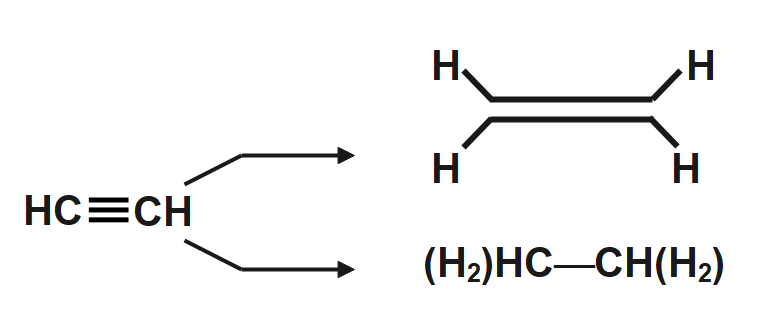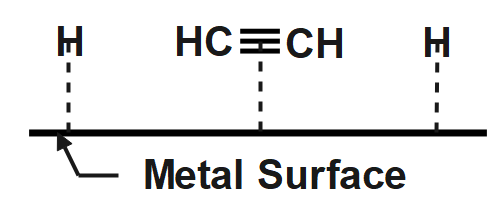
How do you draw the product of the hydrogenation of ethyne?
Answer
441.9k+ views
Hint: We know that the hydrogenation reaction involves the direct reaction of a substrate containing
Complete step by step answer:
When we treat ethyne which is a chemical species represented by

The Hydrogens shown in orange are the hydrogens that are obtained from
Depending on what reagent has been used the partial hydrogenation product

Note: Note that generally for partial hydrogenation a catalyst is poisoned using some chemical species which reduces its reactivity so take note on every species present also when forming ethane you don’t need to show cis-attack as in case of ethane due to presence of only a single bond it can easily rotate and thus no purely cis or trans species can be obtained for ethane.
Complete step by step answer:
When we treat ethyne which is a chemical species represented by

The Hydrogens shown in orange are the hydrogens that are obtained from
Depending on what reagent has been used the partial hydrogenation product

Note: Note that generally for partial hydrogenation a catalyst is poisoned using some chemical species which reduces its reactivity so take note on every species present also when forming ethane you don’t need to show cis-attack as in case of ethane due to presence of only a single bond it can easily rotate and thus no purely cis or trans species can be obtained for ethane.
Latest Vedantu courses for you
Grade 10 | CBSE | SCHOOL | English
Vedantu 10 CBSE Pro Course - (2025-26)
School Full course for CBSE students
₹37,300 per year
Recently Updated Pages
Master Class 9 General Knowledge: Engaging Questions & Answers for Success

Master Class 9 English: Engaging Questions & Answers for Success

Master Class 9 Science: Engaging Questions & Answers for Success

Master Class 9 Social Science: Engaging Questions & Answers for Success

Master Class 9 Maths: Engaging Questions & Answers for Success

Class 9 Question and Answer - Your Ultimate Solutions Guide

Trending doubts
State and prove Bernoullis theorem class 11 physics CBSE

What are Quantum numbers Explain the quantum number class 11 chemistry CBSE

Who built the Grand Trunk Road AChandragupta Maurya class 11 social science CBSE

1 ton equals to A 100 kg B 1000 kg C 10 kg D 10000 class 11 physics CBSE

State the laws of reflection of light

One Metric ton is equal to kg A 10000 B 1000 C 100 class 11 physics CBSE




